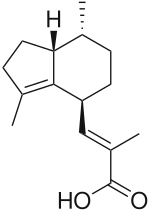
Summary
Valerenic acid is a sesquiterpenoid constituent of the essential oil of the valerian plant.[1]

| |

| |
| Names | |
|---|---|
| Preferred IUPAC name
(2E)-3-[(4S,7R,7aR)-3,7-Dimethyl-2,4,5,6,7,7a-hexahydro-1H-inden-4-yl]-2-methylprop-2-enoic acid | |
| Identifiers | |
| |
3D model (JSmol)
|
|
| ChEBI |
|
| ChemSpider |
|
| ECHA InfoCard | 100.112.154 |
PubChem CID
|
|
| UNII |
|
CompTox Dashboard (EPA)
|
|
| |
| |
| Properties | |
| C15H22O2 | |
| Molar mass | 234.339 g·mol−1 |
Except where otherwise noted, data are given for materials in their standard state (at 25 °C [77 °F], 100 kPa).
Infobox references
| |
Valerian is used as a herbal sedative which may be helpful in the treatment of insomnia.[2] Valerenic acid may be at least partly responsible for valerian's sedative effects, in addition to the other valerenic acids hydroxyvalerenic acid and acetoxyvalerenic acid.[3][1] Valerian supplements are often standardized to contain a particular amount of valerenic acid by weight (often 0.8%).[3]
Valerenic acid acts as a subtype-selective GABAA receptor positive allosteric modulator via a binding site in the transmembrane domain at the β+α− interface.[4] At receptors expressed in Xenopus oocytes (frog eggs) it was shown that only assemblies incorporating β2 or β3 subunits were stimulated by valerenic acid. A study in mice demonstrated that a single amino acid substitution (N265M) in the β3 subunit severely decreases the anxiolytic effect. Modulation of ion channel action was not significantly dependent on incorporation of α1, α2, α3 or α5 subunits.[5]
At the 5-HT5A receptor valerenic acid acts as a partial agonist. This serotonin receptor subtype is distributed in the suprachiasmatic nucleus, a tiny brain region implicated in the sleep-wake cycle.[6]
A study in 2006 found valerian extract as well as valerenic acid to inhibit NF-κB, a protein complex that controls the transcription of DNA, in HeLa (cultured human cancer) cells. This was measured with the IL-6 / Luc (interleukin-6 luciferase) assay as a measurement tool. The study mentioned that such inhibition may be connected to the reported anti-inflammatory action of the valerian plant.[7]
A small study with six human subjects found that valerenic acid peaked in concentration after about an hour and had an average half-life of 1.1 +/- 0.6 hours after oral ingestion of a commercially available valerian root supplement.[8] A later study from the same lab done with sixteen older women found similar values.[3]
See also edit
References edit
- ^ a b Yuan CS, Mehendale S, Xiao Y, Aung HH, Xie JT, Ang-Lee MK (2004). "The gamma-aminobutyric acidergic effects of valerian and valerenic acid on rat brainstem neuronal activity". Anesth Analg. 98 (2): 353–8, table of contents. CiteSeerX 10.1.1.323.5518. doi:10.1213/01.ANE.0000096189.70405.A5. PMID 14742369. S2CID 14526474.
- ^ Bent, Stephen; Padula, Amy; Moore, Dan; Patterson, Michael; Mehling, Wolf (2006). "Valerian for Sleep: A Systematic Review and Meta-Analysis". The American Journal of Medicine. 119 (12). Elsevier BV: 1005–1012. doi:10.1016/j.amjmed.2006.02.026. ISSN 0002-9343. PMC 4394901. PMID 17145239.
- ^ a b c Anderson, Gail D.; Elmer, Gary W.; Taibi, Diana M.; Vitiello, Michael V.; Kantor, Eric; Kalhorn, Thomas F.; Howald, William N.; Barsness, Suzanne; Landis, Carol A. (13 April 2010). "Pharmacokinetics of valerenic acid after single and multiple doses of valerian in older women". Phytotherapy Research. 24 (10): 1442–1446. doi:10.1002/ptr.3151. PMID 20878691. S2CID 21007272.
- ^ Luger D, Poli G, Wieder M, Stadler M, Ke S, Ernst M, Hohaus A, Linder T, Seidel T, Langer T, Khom S, Hering S (2015). "Identification of the putative binding pocket of valerenic acid on GABAA receptors using docking studies and site-directed mutagenesis". Br. J. Pharmacol. 172 (22): 5403–13. doi:10.1111/bph.13329. PMC 4988470. PMID 26375408.
- ^ Khom, S.; Baburin, I.; Timin, E.; Hohaus, A.; Trauner, G.; Kopp, B.; Hering, S. (2007). "Valerenic acid potentiates and inhibits GABAA receptors: Molecular mechanism and subunit specificity". Neuropharmacology. 53 (1): 178–187. doi:10.1016/j.neuropharm.2007.04.018. PMID 17585957. S2CID 7613630.
- ^ Dietz, B.; Mahady, G.; Pauli, G.; Farnsworth, N. (2005). "Valerian extract and valerenic acid are partial agonists of the 5-HT receptor in vitro". Molecular Brain Research. 138 (2): 191–197. doi:10.1016/j.molbrainres.2005.04.009. PMC 5805132. PMID 15921820.
- ^ Jacobo-Herrera, N. J.; Vartiainen, N.; Bremner, P.; Gibbons, S.; Koistinaho, J.; Heinrich, M. (2006). "F-κB modulators from Valeriana officinalis". Phytotherapy Research. 20 (10): 917–919. doi:10.1002/ptr.1972. PMID 16909443. S2CID 44352988.
- ^ Anderson, Gail D.; Elmer, Gary W.; Kantor, Eric D.; Templeton, Ian E.; Vitiello, Michael V. (September 2005). "Pharmacokinetics of valerenic acid after administration of valerian in healthy subjects". Phytotherapy Research. 19 (9): 801–803. doi:10.1002/ptr.1742. PMID 16220575. S2CID 24684779.


